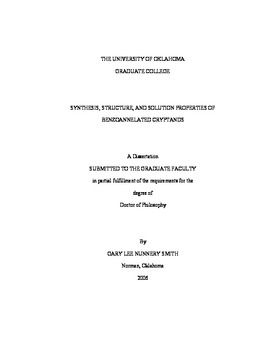| dc.description.abstract | Cryptands An2.2.1 and An2.2.2 were synthesized by high dilution techniques. Attempts to produce An3.1.1 gave primarily the 2 + 2 addition product An3.1.1.3. X-ray crystallography, ESI-MS, and NMR techniques were used to characterize the synthesized cryptands and monocyclic intermediates. The solid-state structures of cryptates An2.2.2.K+· ClO4-. An2.2.2-Pb2+· (NCS-)2, and 2.2B.2B· Pb2+· NCS - were determined and confirmed that the metal ions were located inside the cavity of the macrobicyclic ligand. Protonation constants for An2.2.1 and An2.2.2 are greater than 2.5 pH units below the parent compounds 2.2.1, 2.2.2, and 2.2B.2B. The stepwise protonation constants in water are log KH1 = 5.4, log KH2 = 3.1 for An2.2.1 and log KH1 = 5.3, log KH2 = 3.4 for An2.2.2. The metal formation constants for cryptands An2.2.1 and An2.2.2 are all weaker in comparison to the parent cryptands 2.2.1, 2.2.2, and 2.2B.2B. The metal formation constants (log KML) in water for An2.2.2 with Pb 2+, Cd2+, Ba2+, Sr2+, Ca2+, Na+, and K+ are 8.5, 3.0, 4.7, 4.1, 2.7, 2.4, and 2.0, respectively. The metal formation constants (log KML) in water for An2.2.1 with Pb2+, Cd2+ , Ba2+, Sr2+, Ca2+, Na +, and K+ are 5.0, 4.0, 3.6, 4.2, 4.3, 4.1, and 3.7, respectively. The inherent selectivity of the parent cryptands for lead over the biological cations sodium, potassium, and calcium is present for An2.2.2, but not for An2.2.1. | en_US |
| dc.description.abstract | Macrobicyclic ligands, cryptands, with alkyl nitrogen bridgehead atoms form stable complexes with a wide variety of metal ions. Cryptands 2.2.1 and 2.2.2 have an inherent selectivity for the toxic heavy metals cadmium and lead over important biological cations such as sodium, potassium, and calcium. However, the basicity of the alkyl nitrogen atoms results in significant interference due to protonation reactions in the physiological pH range. To minimize this problem several cryptands were synthesized with aniline (An) nitrogen bridgehead atoms. | en_US |
